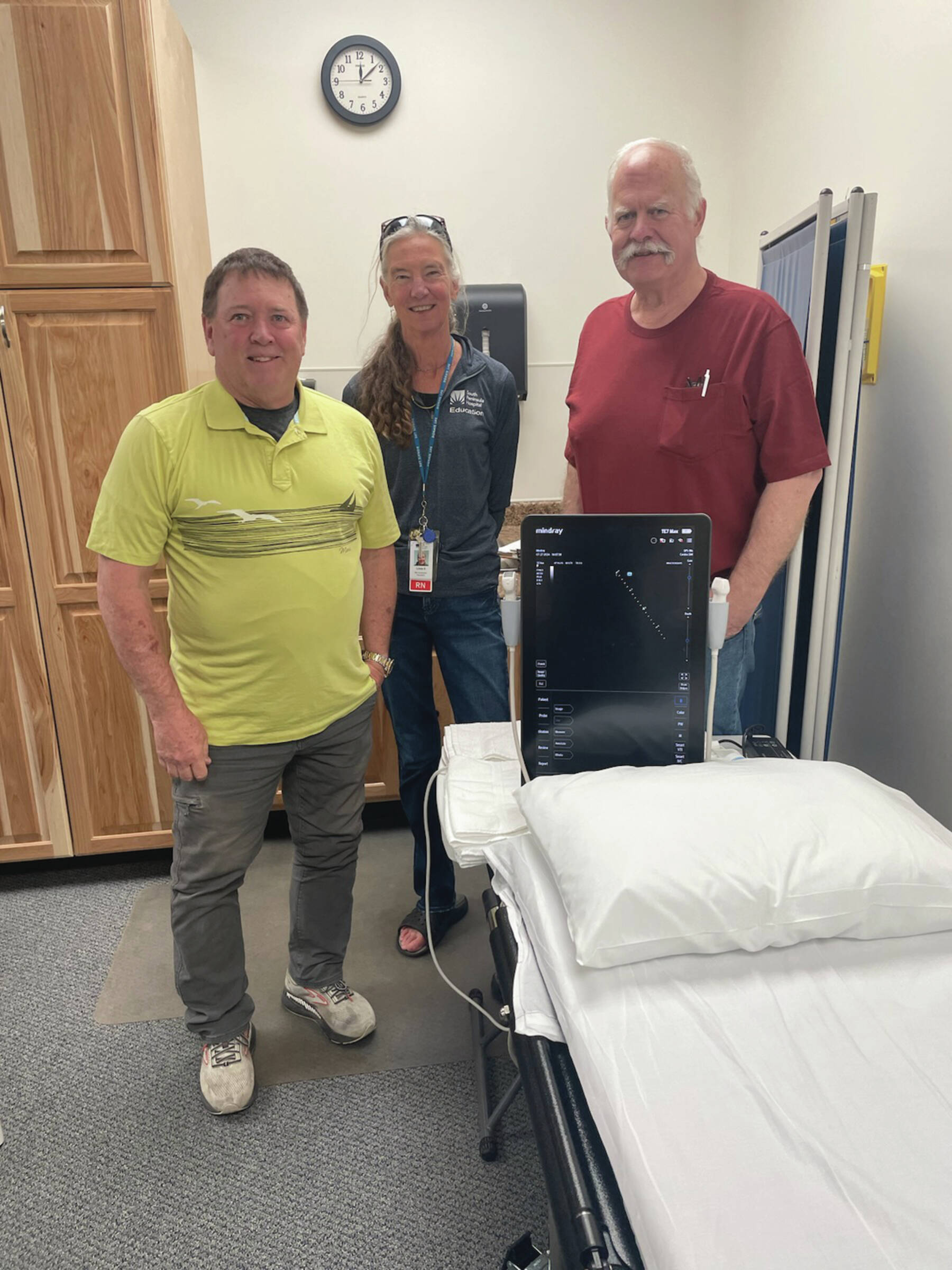South Peninsula Hospital hosted a two-day workshop on ultrasound training on July 26 and 27. The event was attended by 21 doctors from Homer and Providence Hospital in Anchorage.
The training was provided by Dr. Dan Lewis, who came to Homer from Billings, Montana, where he works at the St. Vincent and Holy Rosary hospitals, both a part of Intermountain Health. He brought a team of six additional medical instructors, all board certified in emergency medicine. Four local models also contributed to the workshop for attendees to practice ultrasound techniques.
Dr. Chris Landess, SPH emergency department director, participated in the course when Lewis offered it in Montana. He said the use of ultrasound in emergency medicine is becoming common practice and is a very useful tool in assessing and treating trauma patients by quickly identifying internal injuries and providing accurate diagnoses. “Everybody here is very excited about using ultrasound to make faster, more accurate diagnoses in the ER so that we can take care of people in a more time efficient manner,” Landess said.
Participants at the event were also appreciative that the team was able to provide the event in Homer, Landess said. “I think it’s built upon the excitement. It’s really nice to have the continuing medical education here in Homer, as opposed to having to travel out of state or even up to Anchorage,” Landess said.
Lewis defined the hospital where he works as a critical access hospital that’s a little smaller than Homer’s. “We realized that there was a tool that we weren’t using very much to help make good clinical decisions in the emergency department and most clinics have access to this tool, the ultrasound machine,” he said.
Lewis provided an example of how it might improve diagnosis. “When a trauma patient comes in you can take an ultrasound to the bedside without the patient having to go to radiology or leave the department or in a place where the hospital doesn’t have a CT scanner. You can put the ultrasound probe on the abdomen and see if there’s blood in there,” he said.
Other examples he noted were probing the heart to identify an effusion or fluid around the heart from trauma or using it on the chest and see if the patient has a collapsed lung. It can also be used to look at the kidney, bladder and gallbladder.
Because these assessments can be done on-site, based on findings from an ultrasound, doctors can do an intervention without the patient ever having to leave the department.
Landess agreed that the tool provides much more time efficient care. “We’re talking a matter of one to five minutes to make a decision, as opposed to 15 to 30 minutes to wait for them to go to the X-ray department and then return to the emergency room.”
Lewis also described ultrasound as a modality that doesn’t hurt anybody and can be used repeatedly — this is especially useful for emergency patients who may be changing clinically over short periods of time. “They don’t just come in to ER and they stay in the same status. Maybe they’ve got a little bit of blood in their belly. But then 10 minutes later, I can look again and see if there’s a significant increase.”
“To reiterate, it’s very safe. We can do ultrasounds on somebody all day long. There’s no radiation, there’s no ill effects, there’s no risk to the patient. That’s not always true of other imaging modalities, like plain X-rays or CT scans, the radiation that accumulates in your body from those things is cumulative over a lifetime.” Landess said. Ultrasound is not like that, it can be repeated as frequently as necessary, he said.
Linda Stearns, from SPH’s education department, said in addition to the basic training, the workshop provided an opportunity for local doctors to network with other physicians around the state, as well as networking with people around the country. This is the first time that SPH has offered a continuing medical education activity for providers that has brought in content expert presenters from coast to coast.
Landess said participants at the event included advanced practice providers, nurse practitioners as well as a medical student. “It’s open to anyone who wants to learn,” he said.
Lewis said this particular course has been offered 14 times, typically in Montana, Wyoming and Idaho, and that it is especially useful for critical access hospitals.
A critical access hospital is a federal designation for hospitals that provide essential services in rural communities. It means that “the facility can get assistance with costs of running the operation, because otherwise the hospitals couldn’t stay open,” he said.
This is a huge issue in Alaska with small population communities and limited access to health care, he said.
“If this hospital was not designated as a critical access hospital and didn’t have that little bit of extra support from the government, it might not exist, and that would be harmful to our community on the southern Kenai Peninsula, especially for emergency care where the next closest facility is in Soldotna,” Landess said.
A critical access hospital must have 25 or fewer acute care inpatient beds, be located more than 35 miles from another hospital, maintain an annual average length of stay of 96 hours or less for acute care patients and provide 24/7 emergency care services, according to a rural health information website.
Landess noted that the doctors provided the training as volunteers. The only thing the course fee covered was the costs of the doctors travel to get to Homer. The ultrasound machines were also provided by donation from a company called Mindray, which also donated shipping for the machines.
“This course is a great opportunity and we have so much excitement within this group right now to start using this technology more often and really providing better care for patients,” Landess said.



